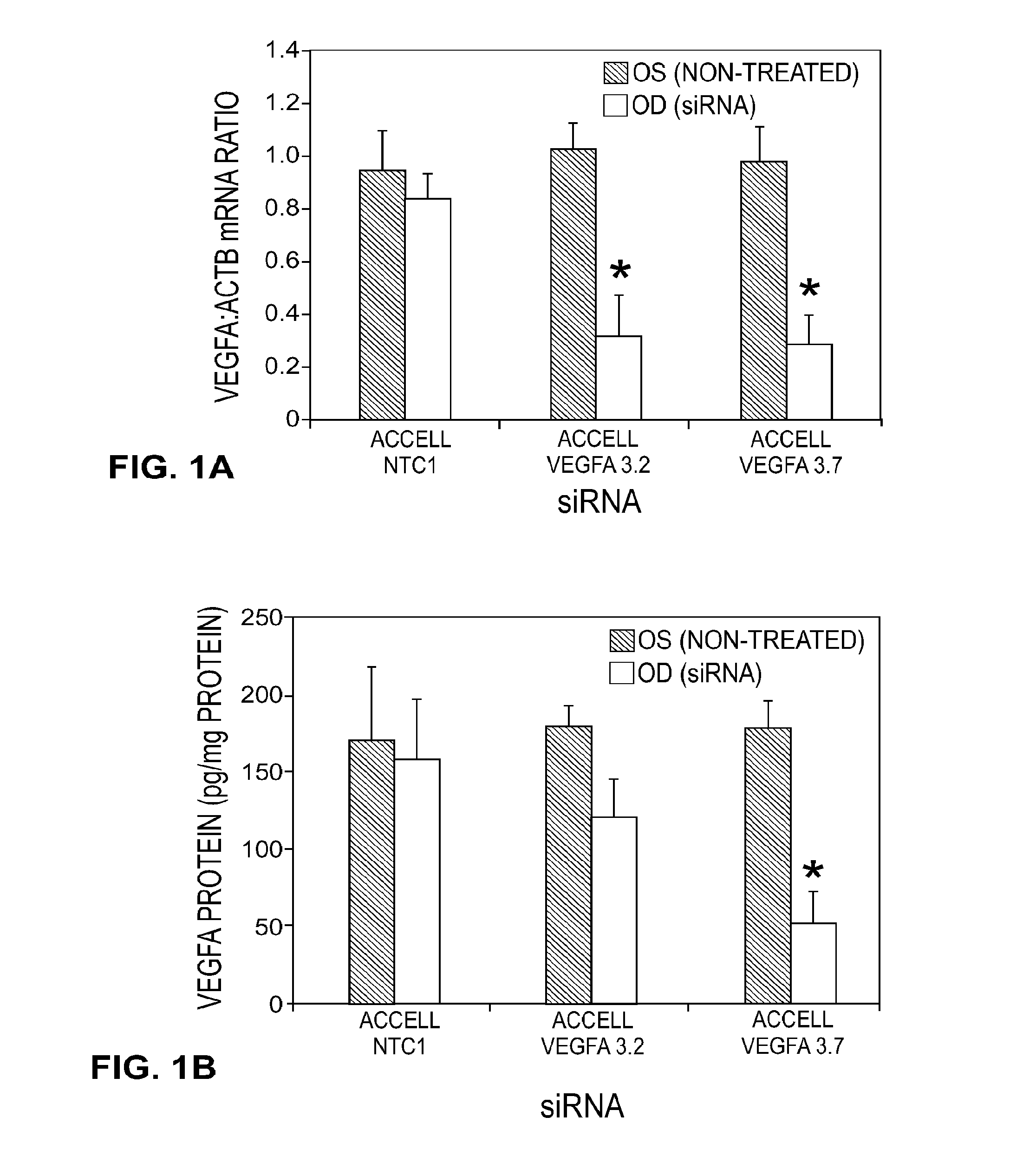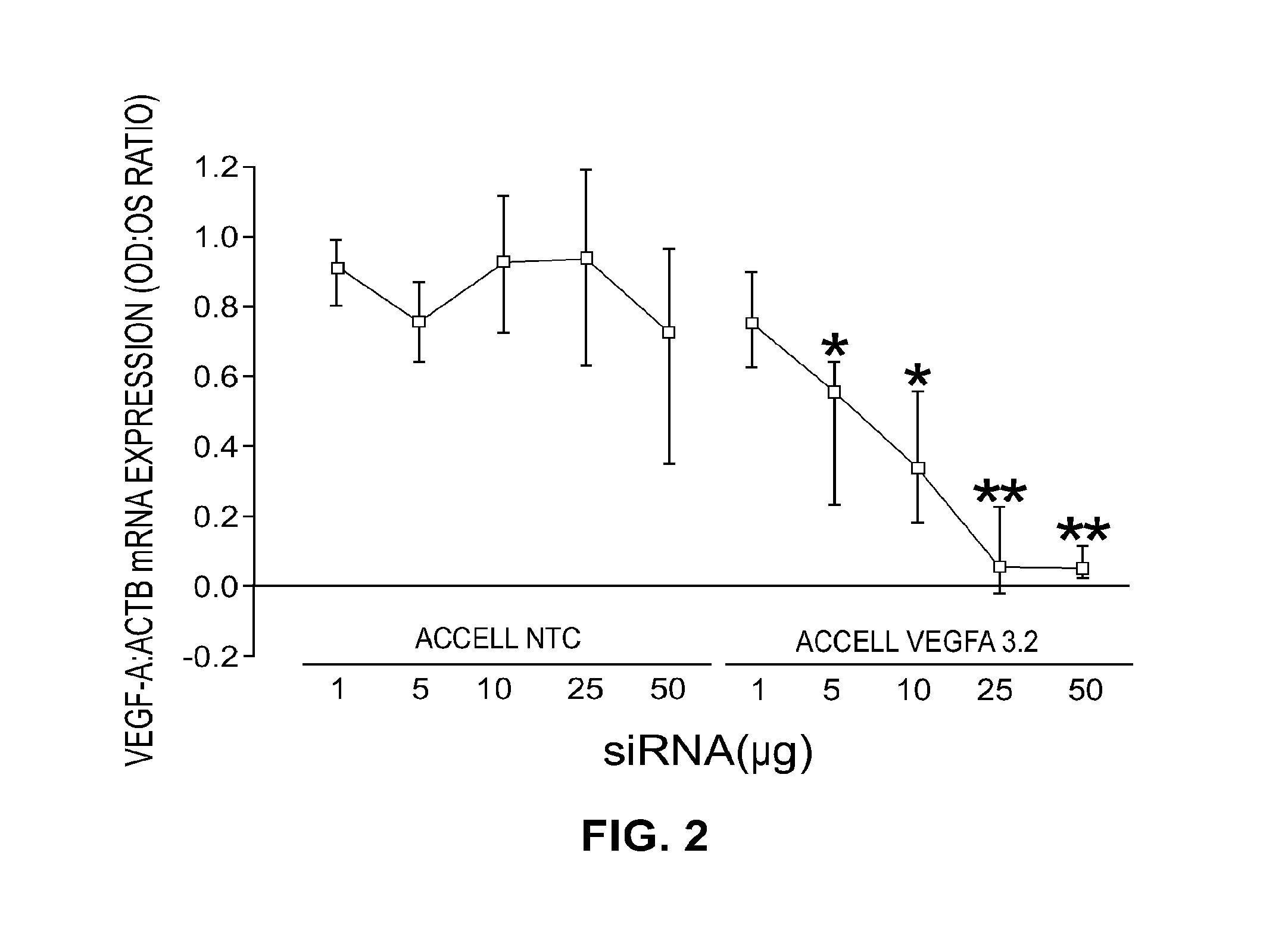Sirna targeting vegfa and methods for treatment in vivo
a technology of vegfa and vegfa targeting, which is applied in the field of sirna, can solve the problems of high vegfa levels and concomitant increases in vascularization, and achieve the effects of effectively treating a subject, modulating the expression or activity of one or more target polypeptides, and inhibiting the expression of the polypeptide encoded
- Summary
- Abstract
- Description
- Claims
- Application Information
AI Technical Summary
Benefits of technology
Problems solved by technology
Method used
Image
Examples
example 1
General Techniques for In Vitro Studies
[0113]siRNA Selection for Study
[0114]A collection of siRNAs capable of targeting all the variants of VEGFA were identified (NM—001025366, NM—003376, NM—001025367, NM—001025368, NM—001033756, NM—001025369, NM—001025370). Table 1 provides a list of the siRNAs along with the sense and antisense strand sequences (5′→3′).
[0115]To assess the relative functionality of each siRNA, sequences were synthesized using 2′ ACE chemistry (U.S. Pat. No. 6,008,400; U.S. Pat. No. 6,111,086; U.S. Pat. No. 6,590,093; Scaringe (2000) Methods in Enzymology 317:3-18; Scaringe (2001) Methods 23(3):206-217) and then transfected into HeLa cells (ATCC, #CCL-2) by lipid mediated transfection using the manufacturer's protocols (10,000 cells per well in a 96 well format, 100 nM siRNA, 0.2 μl DharmaFECT 1 / well). Seventy-two hours post-transfection, overall cell viability and target knockdown at the mRNA and protein level was determined. All assays were performed in triplicate...
example 2
Results of In Vitro and In Vivo Studies
[0134]The performance of all the sequences tested in vitro is shown in Table 1. Multiple sequences were observed to provide greater than 70% gene knockdown at both the RNA and protein level including, for instance, Vegfa 2.2, 2.3, 2.4, 2.12, 3.1, 3.2, 3.3, 3.5, and 3.7. In addition, when a subset of the collection was tested with the stabilized design, overall performance was found to be equivalent or better than that observed in the unmodified state (see, for instance, vegfa 2.1, 3.2, 3.3). As Table 2 shows, in both the unmodified and modified states, IC50 for RNA knockdown ranged from approximately 0.11→23 nM while IC50 for protein knockdown ranged from ˜0.17→3.17 nM. Based on these results, two sequences, Vegfa 3.2 and 3.7, were re-synthesized using the in vivo design (referred to as “Accell”) described previously. The results of these experiments may be further demonstrated by reference to the accompanying figures.
[0135]FIGS. 1A and 1B illu...
PUM
 Login to View More
Login to View More Abstract
Description
Claims
Application Information
 Login to View More
Login to View More - R&D
- Intellectual Property
- Life Sciences
- Materials
- Tech Scout
- Unparalleled Data Quality
- Higher Quality Content
- 60% Fewer Hallucinations
Browse by: Latest US Patents, China's latest patents, Technical Efficacy Thesaurus, Application Domain, Technology Topic, Popular Technical Reports.
© 2025 PatSnap. All rights reserved.Legal|Privacy policy|Modern Slavery Act Transparency Statement|Sitemap|About US| Contact US: help@patsnap.com



